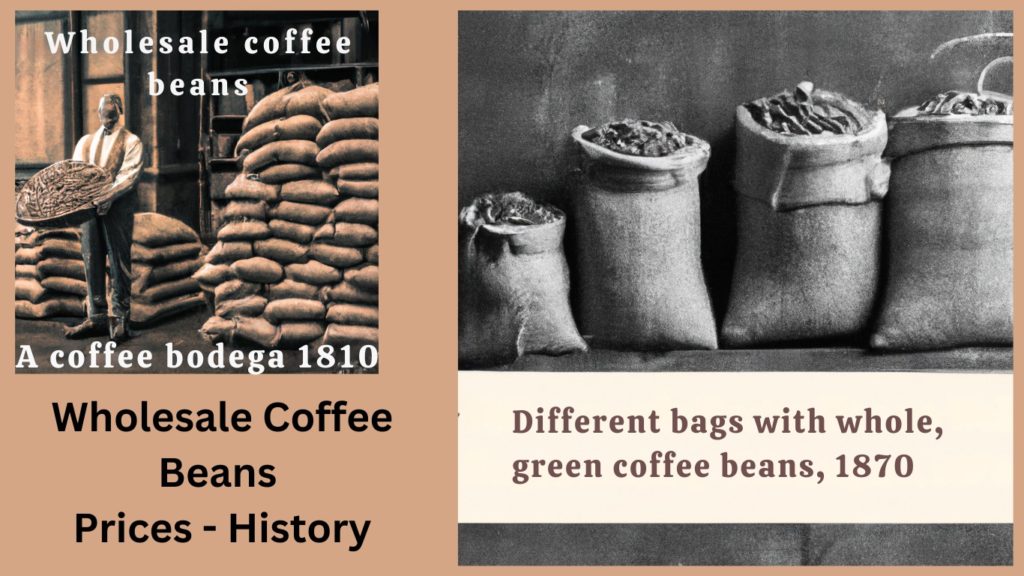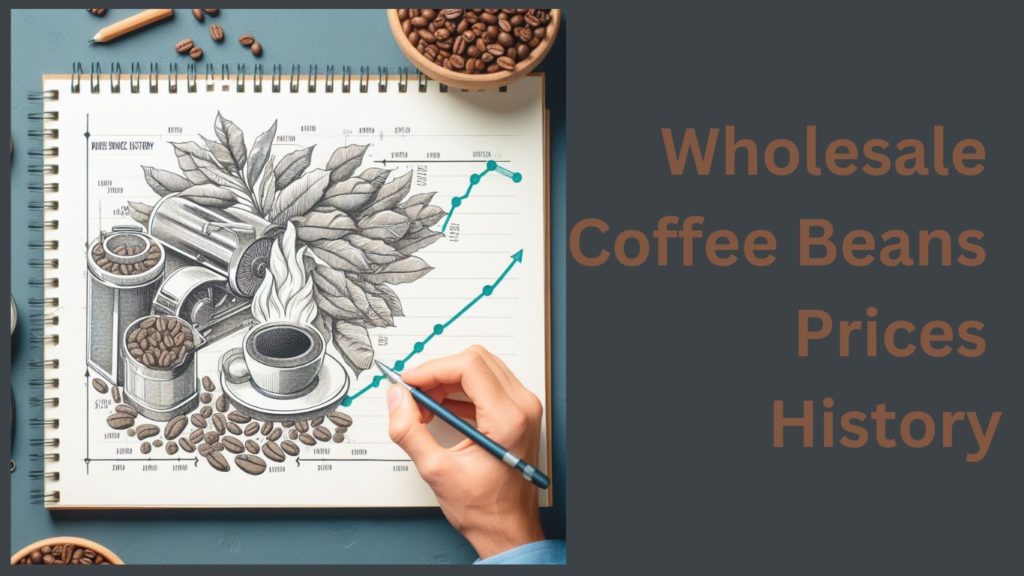Did you know that the wholesale coffee beans price in 1600 was around 3 shillings per pound, or $18,75? Coffee is one of the most traded commodities in the world, with millions of people consuming it every day. But how much does it cost to produce and buy coffee beans? And how has the price changed over time?
In this article “Wholesale Coffee Beans Prices History”, we will explore the history of coffee bean prices, from the 16th century to the present day. We will also look at the factors that affect the price of coffee beans, such as supply and demand, weather conditions, production costs, and global economic trends.
Finally, we will give a forecast of coffee bean prices for 2024, based on the latest data and projections.
In this blog post we will look at the following:
Wholesale Coffee Beans Prices History by Type and Country
There are two main types of coffee beans that are traded on the global market: Arabica and Robusta. Arabica beans are more aromatic and flavorful, but also more sensitive to pests and diseases.
Robusta beans are more bitter and stronger, but also more resistant to harsh conditions. Arabica beans account for about 60% of the global coffee production, while Robusta beans account for about 40%.
The price of coffee beans varies depending on the type, quality, and origin of the beans. Different countries have different production costs, export policies, and market conditions that affect the price of their coffee beans.
The table below shows the average prices of Arabica and Robusta beans from the top 10 coffee-producing countries in 2022, according to Statista. The prices are based on the green coffee equivalent of 60 kg bags.
| Country | Arabica Price (USD/kg) | Robusta Price (USD/kg) |
|---|---|---|
| Brazil | 4.50 | 2.10 |
| Vietnam | N/A | 1.80 |
| Colombia | 5.00 | N/A |
| Indonesia | N/A | 2.00 |
| Ethiopia | 5.50 | N/A |
| Honduras | 4.80 | N/A |
| India | 4.20 | 1.90 |
| Uganda | N/A | 1.70 |
| Peru | 4.70 | N/A |
| Mexico | 4.60 | N/A |
As we can see from the table, Arabica beans are generally more expensive than Robusta beans, reflecting their higher quality and demand. Brazil is the largest producer and exporter of both Arabica and Robusta beans, followed by Vietnam for Robusta and Colombia for Arabica.
Ethiopia is the largest producer of organic coffee in the world, which commands a premium price. India and Uganda produce both types of beans, while the other countries specialize in one type.
Coffee Bean Prices Over Time
The price of coffee beans has fluctuated significantly over time, depending on various factors such as supply and demand, weather conditions, production costs, and global economic trends. The chart below shows the historical prices of Arabica and Robusta beans from 2000 to 2022, according to Trading Economics. The prices are in nominal US cents per pound.
As we can see from the chart, Arabica prices reached a peak of 339.86 cents per pound in April 2011, driven by a supply shortage caused by adverse weather conditions in major producing countries such as Brazil and Colombia. Robusta prices also reached a peak of 231.24 cents per pound in March 2011, due to strong demand from emerging markets such as China and India.
On the other hand, Arabica prices reached a low of 41.50 cents per pound in October 2001, due to a supply glut caused by overproduction in Brazil and Vietnam. Robusta prices also reached a low of 45.10 cents per pound in November 2001, due to weak demand from developed markets such as Europe and North America. Read more on the topic of Vietnamese coffee vs American coffee.
Wholesale Coffee Beans Price in 1600
OK, so it is not so easy to give an exact price. There is no definitive answer to how much wholesale coffee beans cost in 1600, as the price of coffee beans varied depending on the type, quality, origin, and market conditions of the beans, as well as the region where they were produced and consumed.
Moreover, the data on coffee bean prices in the 16th century were scarce and unreliable, as the coffee trade was not well established and regulated at that time. But here are some ideas:
According to one source, the average price of coffee beans in Europe in 1600 was about 3 shillings per pound, which is equivalent to about $18.75 in 2020 US dollars2. However, this price was likely inflated by the high transportation costs and taxes imposed by the Ottoman Empire, which controlled most of the coffee-producing regions in Africa and Asia. The price of coffee beans in the Ottoman Empire was much lower, ranging from 0.5 to 1.5 piastres per pound, which is equivalent to about $0.25 to $0.75 in 2020 US dollars.
Another source suggests that the price of coffee beans in Mocha, Yemen, which was the main port of export for coffee in the 16th century, was about 20 dirhams per quintal (100 kg), which is equivalent to about $0.02 per kg or $0.01 per pound in 2020 US dollars. However, this price was likely depressed by the oversupply and low quality of coffee beans in Mocha, as the Yemeni farmers often mixed their coffee with other substances such as husks, stones, or dirt. Yak…
Therefore, the price of wholesale coffee beans in 1600 depended on many factors and varied widely across different regions and markets. It is difficult to compare the prices of coffee beans in different currencies and time periods, as the exchange rates and inflation rates are not constant or accurate. The best way to estimate the price of wholesale coffee beans in 1600 is to look at the relative value of coffee beans compared to other commodities or goods at that time.
The Oldest, But Most Reliable Wholesale Coffee Beans Prices History
According to the Tridge database, the oldest available price for wholesale coffee beans is from 1969, when the ICO started to collect and publish monthly price data for Arabica and Robusta beans.
The average price of Arabica beans in 1969 was 64.32 US cents per pound, while the average price of Robusta beans was 36.95 US cents per pound. These prices are based on the ICO composite indicator, which is a weighted average of prices for different groups of coffee beans traded in various markets.
Coffee Bean Prices in Recent Years
If you are thinking about how to make your own coffee brand, you might also be interested in the prices going forward. In recent years, Arabica prices have been more volatile than Robusta prices, reflecting their higher sensitivity to weather shocks and market fluctuations. Robusta prices have been more stable, reflecting their lower production costs and consistent demand.

Wholesale Coffee Beans Prices: Many Factors
Many factors affect the price of coffee beans, such as supply and demand, weather conditions, production costs, and global economic trends. Here are some of the main factors that influence the price of coffee beans:
- Supply: The supply of coffee beans depends on the production volume and quality of coffee-producing countries. Production volume is affected by factors such as land area, yield, pest and disease control, labor availability, infrastructure development, and environmental sustainability. Production quality is affected by factors such as soil fertility, climate variability, harvesting methods, processing techniques, and storage conditions.
- Demand: The demand for coffee beans depends on the consumption patterns and preferences of coffee-drinking countries. Consumption patterns are affected by factors such as population growth, income level, urbanization, lifestyle, and health awareness. Consumption preferences are affected by factors such as taste, aroma, freshness, variety, and social responsibility.
- Weather conditions: Weather conditions have a significant impact on the production and quality of coffee beans. Extreme weather events such as droughts, floods, frosts, hurricanes, and pests can damage or destroy coffee crops, reducing the supply and increasing the price of coffee beans. On the other hand, favorable weather conditions such as adequate rainfall, sunshine, and temperature can boost coffee yields and quality, increasing the supply and lowering the price of coffee beans.
- Production costs: Production costs include the expenses incurred by coffee farmers and producers to grow, harvest, process, transport, and store coffee beans. Production costs are influenced by factors such as input prices, labor wages, energy costs, transportation costs, and taxes. Higher production costs can reduce the profitability and competitiveness of coffee producers, leading to lower supply and higher prices of coffee beans. Lower production costs can increase the profitability and competitiveness of coffee producers, leading to higher supply and lower prices of coffee beans.
Who Gets the Money from Coffee Beans?
The price of coffee beans is not only determined by the market forces of supply and demand but also by the distribution of value along the coffee value chain. The coffee value chain consists of the actors and activities involved in the production, processing, trade, and consumption of coffee beans. The main actors in the coffee value chain are:
- Coffee farmers: They are the ones who grow, harvest, and sell coffee beans to intermediaries or exporters. They usually receive the lowest share of the final price of coffee beans, ranging from 5% to 25%, depending on the type, quality, and origin of the beans. Coffee farmers face many challenges such as low and volatile prices, high production costs, lack of access to credit, inputs, and markets, and environmental and social risks.
- Intermediaries: They are the ones who buy coffee beans from farmers and sell them to exporters or processors. They can be local traders, cooperatives, or associations. They usually receive a small margin of the final price of coffee beans, ranging from 2% to 10%, depending on their bargaining power and the services provided. Intermediaries play an important role in providing liquidity, information, and quality control to the coffee market.
- Exporters: They are the ones who buy coffee beans from intermediaries or farmers and sell them to importers or roasters. They can be private companies, state agencies, or multinational corporations. They usually receive a moderate share of the final price of coffee beans, ranging from 10% to 20%, depending on their market position and value addition. Exporters are responsible for transporting, storing, grading, and marketing coffee beans to international buyers.
- Importers: They are the ones who buy coffee beans from exporters and sell them to roasters or retailers. They can be brokers, agents, or distributors. They usually receive a similar share of the final price of coffee beans as exporters, ranging from 10% to 20%, depending on their market role and service delivery. Importers are involved in clearing, financing, hedging, and distributing coffee beans to domestic buyers.
- Roasters: They are the ones who buy coffee beans from importers or exporters and process them into roasted coffee products. They can be large-scale industrial roasters or small-scale artisanal roasters. They usually receive the highest share of the final price of coffee beans, ranging from 30% to 50%, depending on their brand reputation and product differentiation. Roasters are in charge of roasting, blending, flavoring, packaging, and labeling coffee products for consumers.
- Retailers: They are the ones who buy roasted coffee products from roasters or distributors and sell them to consumers. They can be supermarkets, convenience stores, specialty shops, or cafes. They usually receive a significant margin of the final price of roasted coffee products, ranging from 20% to 40%, depending on their location and customer service. Retailers are the main interface between consumers and coffee products.
The table below shows an example of how the value is distributed along the coffee value chain for a pound of Arabica coffee sold in a US supermarket for $10 in 2022. The percentages may vary depending on the type, quality, origin, and market conditions of the coffee.
| Actor | Price (USD) | Percentage |
|---|---|---|
| Farmer | 0.50 | 5% |
| Intermediary | 0.60 | 6% |
| Exporter | 1.00 | 10% |
| Importer | 1.00 | 10% |
| Roaster | 3.00 | 30% |
| Retailer | 4.00 | 40% |
| Total | 10.00 | 100% |
As we can see from the table, there is a large gap between what the farmer receives and what the consumer pays for a pound of coffee. This gap reflects the unequal distribution of value and power along the coffee value chain.
If this is too many numbers for you, you might enjoy the Best Italian Coffee Machine Reviews better.
Coffee Wholesale Prices Forecast
The future of coffee wholesale prices is uncertain, as there are many factors that can affect the supply and demand of coffee beans in the global market. However, based on the latest data and projections from various sources, we can try to give a forecast of coffee bean prices for 2024.
According to the International Coffee Organization (ICO), the global coffee production for 2022/23 is estimated to be 175.1 million bags, a slight increase of 0.7% from 2021/22.
The global coffee consumption for 2022/23 is projected to be 177.4 million bags, a moderate increase of 2.4% from 2021/22. This implies a global coffee deficit of 2.3 million bags for 2022/23, which could put upward pressure on coffee bean prices.
According to the US Department of Agriculture (USDA), the average price of Arabica beans for 2022/23 is forecasted to be 140 cents per pound, a slight decrease of 0.7% from 2021/22.
The average price of Robusta beans for 2022/23 is forecasted to be 100 cents per pound, a slight increase of 0.5% from 2021/22.
The price difference between Arabica and Robusta beans is expected to narrow, as the demand for Robusta beans increases due to their lower cost and higher caffeine content.

According to the World Bank, the nominal price index of coffee beans for 2024 is projected to be 109.9, a moderate increase of 4.8% from 2023. The real price index of coffee beans for 2024 is projected to be 83.8, a slight increase of 0.9% from 2023.
The nominal price index measures the change in the current US dollar price of coffee beans, while the real price index measures the change in the constant US dollar price of coffee beans adjusted for inflation.
Read about the future of coffee called coffee 2.0.
Coffee Bean Prices by Region
The price of coffee beans can also vary depending on the region where they are produced and consumed. Different regions have different climatic conditions, production systems, consumption habits, and market dynamics that affect the price of coffee beans.
The table below shows the average coffee wholesale prices of Arabica and Robusta beans by region in 2022, according to Tridge. The prices are in US dollars per kilogram.
| Region | Arabica Price (USD/kg) | Robusta Price (USD/kg) |
|---|---|---|
| Africa | 4.80 | 1.90 |
| Asia | N/A | 1.80 |
| Central America | 5.00 | N/A |
| Europe | N/A | N/A |
| North America | N/A | N/A |
| Oceania | N/A | N/A |
| South America | 4.50 | 2.10 |
As we can see from the table, Africa has the highest average price for both Arabica and Robusta beans, reflecting its high-quality and diverse coffee varieties. Asia has the lowest average price for Robusta beans, reflecting its large-scale and low-cost production.
Central America has the highest average price for Arabica beans, reflecting its specialty and organic coffee segments. South America has a moderate average price for both Arabica and Robusta beans, reflecting its balanced and competitive coffee industry.
Conclusion – Wholesale Coffee Beans Prices History
Coffee bean prices are influenced by many factors, such as supply and demand, weather conditions, production costs, and global economic trends. The price of coffee beans also varies depending on the type, quality, and origin of the beans, as well as the region where they are produced and consumed.
If you like numbers like me, make sure to check out the Which Country Drinks the most coffee 2024 article I made earlier.
The history of coffee bean prices shows that they have fluctuated significantly over time, depending on various market forces and shocks. The forecast of coffee bean prices for 2024 suggests that they will increase moderately, due to a projected global coffee deficit and a higher demand for Robusta beans.
I hope you enjoyed this article about wholesale coffee beans prices history. If you want to learn more about coffee and its fascinating world, you can visit my coffee blog here. You can also subscribe to the newsletter and follow me on social media for the latest updates and tips on coffee.
Thank you for reading and happy brewing! ☕

